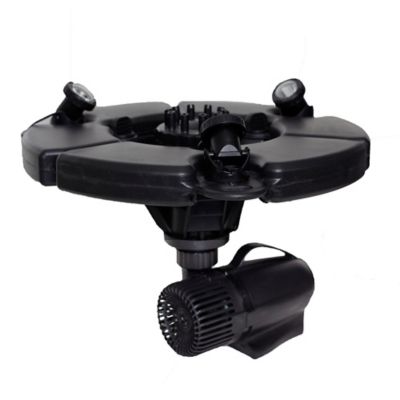Airmax PondSeries Pond Aeration System, PS10, 1 Diffuser, 115V, (1) 100 ft. Roll of 3/8 in. Airline, Aerates Up to 1 Acre
Aeration systems utilize a shore-mounted air pump that delivers air to a specialized diffuser plate that is located on the pond bottom. Resulting in a column of rising bubbles that circulates water throughout the pond, eliminating a change in temperature or thermocline.
Aeration systems utilize a shore-mounted air pump that delivers air to a specialized diffuser plate that is located on the pond bottom. Resulting in a column of rising bubbles that circulates water throughout the pond, eliminating a change in temperature or thermocline. with increased oxygen and added natural bacteria, any excess nutrients in the pond or lake are metabolized, resulting in cleaner, clearer water, and less muck. Results you can see in just 90 days! Easy Installation with Options – Airmax Aeration Systems are the easiest and most versatile systems to install on the market. PondSeries PS10 System can be installed at the water’s edge or up to 1/4 mile away from the pond or lake. No power is needed at the shore. Airmax EasySet airline delivers oxygen to the water without the added expense of hiring an electrician. Airmax Composite Cabinet – ETL electrical safety certified composite cabinet has a quiet design with a faux rock finish to blend into any landscape. The removable top and side high-density air intake filter protect the compressor and pre-wired electrical box from outside contaminants while providing easy access. Other cabinet features include an elevated base protecting against damaging flood water and a ventilation fan with a rain shroud that cools and protects against moisture and heat damage. Cabinet dimensions: 23 in.L x 17 in.W x 15 in.H. Comes with a 10-year warranty. SilentAir Compressor with SmartStart Technology (IST) – The heart and soul of each PondSeries Aeration System is a powerful whisper-quiet SilentAir 1/4 HP Rocking Piston Compressor built with SmartStart Technology (IST) to protect the compressor during pressurized restarts following power supply interruptions. Each highly efficient 115V compressor comes with rubber mounts to reduce noise and vibrations to ensure a silent operation. This compressor can push up to 2.3 CFMs of oxygen to your pond while costing as little as $0.44 a day. Comes with a 3-year warranty. Airflow Manifold Assembly – Airmax simplifies airflow management to an individual diffuser with a single-port manifold. Optional airline quick disconnects can be added for simplified removal during maintenance or for winter storage of systems that do not run year-round. PondSeries PS10 Systems is set up for 3/8 in. or 5/8 in. airlines. ProAir 4 Weighted Diffusers – Designed for maximum oxygen uptake, the ProAir 4 Weighted Diffuser incorporates high-efficiency low-maintenance membrane sticks to release tiny oxygen bubbles into the water column. Membrane diffusers have the synergy of air stones without the headaches of cracking and acid-washing. The ProAir 4 Weighted Diffuser has an integrated check valve to prevent back pressure on the compressor. The innovative sled design keeps the ProAir 4 submerged while maintaining an upright position during installation. Comes with a 5-year warranty.
- Airmax pond aeration system aerates ponds or small lakes up to 1 acre at up to 50 ft. deep
- ETL Electrical Safety Certification
- Extremely efficient rocking-piston compressor keeps your system going
- Airmax ETL composite cabinet comes with a pre-wired electrical box and 6 ft. power cord
- SilentAir series aeration compressor pushes oxygen through your pond while remaining energy efficient
- ProAir4 weighted diffuser uses high-efficiency low-maintenance membrane sticks to release tiny oxygen bubbles into the water column
- EasySet weighted airline resists rips and tears and is guaranteed not to float
- Running Amps: 1.6 amps
- Volts: 115V
- Max Air Flow: 2.3 CFM
- Max Diffuser Depth: 50 ft.
- Max Pond Size: 1 acre
- Approximate pond aeration kit operating cost/month: $13.20
- Airmax Composite Cabinet comes with a 10-year warranty, a 3-year warranty on electrical components
- ProAir4 Diffuser comes with a 5-year warranty
Additional information
| Aerator Type | Bottom Diffuser Aerators |
|---|---|
| Air Line Length | 100 ft. |
| Amperage | 1.6A |
| Cord Length | 6 ft. |
| Horsepower | 0.25 HP |
| Maximum Airflow Rate | 2.3 CFM |
| Maximum Pond Size | 1 acre |
| Maximum PSI | 30 PSI |
| Maximum Recommended Pond Depth | 21 ft. |
| Number Of Outlets | 2 |
| Power Type | Electric |
| Product Height | 24 in. |
| Product Length | 25 in. |
| Product Width | 23 in. |
| Product Weight | 72 lb. |
| Voltage | 115V |
| Warranty | Lifetime – Cabinet; 5 Years – Airline & Diffuser; 2 Years – Compressor |



by Ben
Great complete system, simple setup, excellent performance. Keeps the water moving well, was able to revive a stagnant old pond and save some fish.
by Greg
We were especially impressed with the quality of the unit when it was delivered. Enclosed instructions were thorough and we found videos posted by the manufacturer to be really, really helpful in demonstrating installation. Two of us had no trouble placing the aerator in our pond, saving us a considerable amount compared to the bid from a local aquatic contractor. The unit has been running now for more than a month and seems to have a positive effect on the water. The noise from the compressor is slightly noticeable (it sounds like swimming pool equipment). But I realize this is inevitable and it is not really intrusive. We’re very satisfied with our purchase.